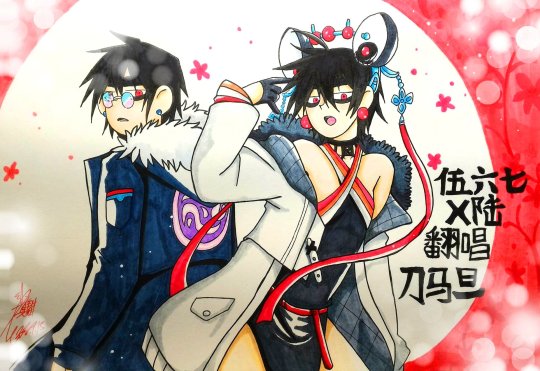#daomadan
Photo





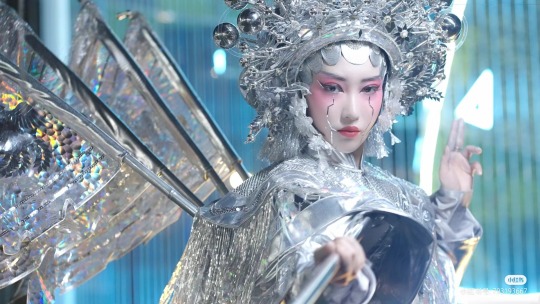
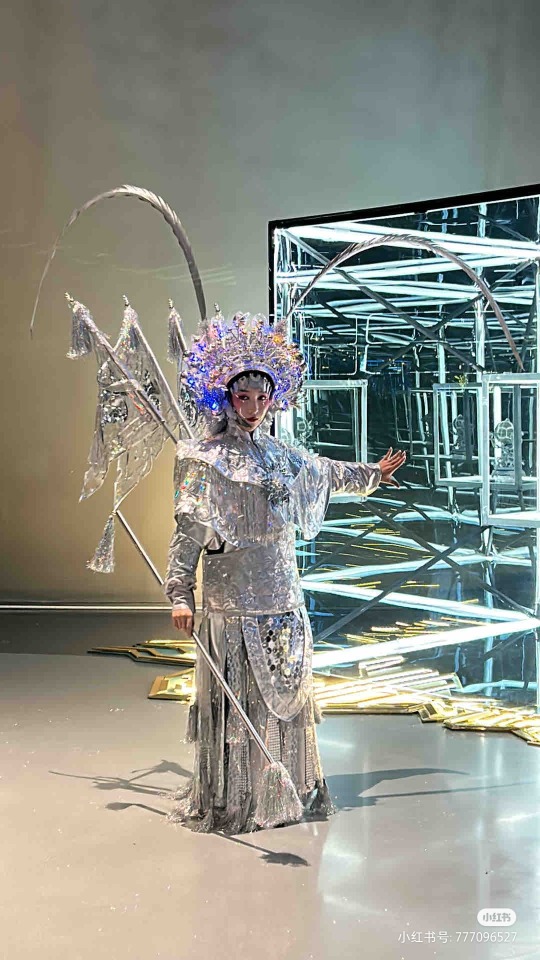

cyberpunk daomadan刀马旦 of chuanju川剧 (sichuan opera) at World Science Fiction Convention 2023 by 雁鸿Aimee
#china#fun#WSFC#world science fiction convention#photography#cyberpunk#op named her work as 川剧机械梦幻少女#daomadan#chuanju
4K notes
·
View notes
Text
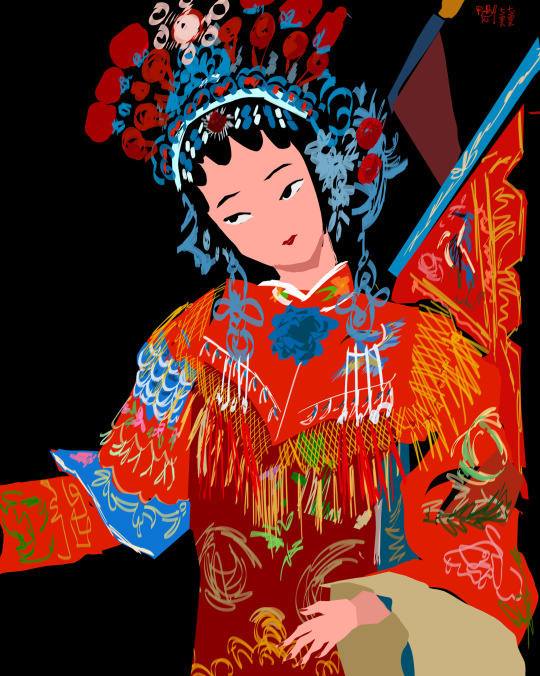
刀馬旦
daomadan
3 notes
·
View notes
Text
About Yunjin’s Design
Yunjin is based on the daomadan (刀马旦) character archetype in Beijing Opera. Dan (旦) means female role, and daoma (刀马) means “saber and horse”, referring to the type of action that’s characteristic of this role. Altogether daomadan is a female role that fights on horseback in the course of the story. This type of female character is often a heroic warrior, and sometimes even a general leading troops in battle. If the female role does not fight on horseback, then it’s generally referred to as wudan (武旦), or “martial female role”. Daomadan can be understood as a subtype of wudan.
This is supported by both what Yunjin did in her character demo and one of her idle animations, where she twirls and kicks a baton-like object. In Beijing Opera, this “baton” is understood to represent a spear or a spear-like polearm weapon, and the acrobatics represent the moves when fighting. Here is a video excerpt example from an old opera named Oulianguan (《藕连关》). The daomadan character enters the stage at 0:42 and is seen fighting multiple male warrior characters in a battle, then rejoicing in victory.
On Yunjin’s visual design, although it’s overall more lolita than traditional, it does still contain a few design elements from Beijing Opera:
The shawl-like clothing around her shoulders is a reference to yunjian (云肩; lit. “shoulder cloud”) worn by certain dan characters in Beijing Opera, usually noble, royal, wealthy, or significant female characters.
The pom-pom-like things in her hat refers to parts of the daomadan headwear qixingezi (七星额子; lit. “seven stars headwear”), meant to represent decorations on a helmet.
The flags seen on her back during her elemental skill is a direct reference to the kaoqi (靠旗, or “armor flags”) worn by major characters who are generals or warriors fighting on the battlefield. This applies to both male and female roles. Characters who are generals but do not appear in battle (ex: Guanyu) may not have kaoqi in their costumes.
Here’s a diagram illustrating the parts of a typical daomadan costume, with the relevant parts translated:

And here’s a typical daomadan costume in real life, specifically the costume for Mu Guiying in the opera “Mu Guiying Takes Command” (《穆桂英挂帅》).

255 notes
·
View notes
Photo
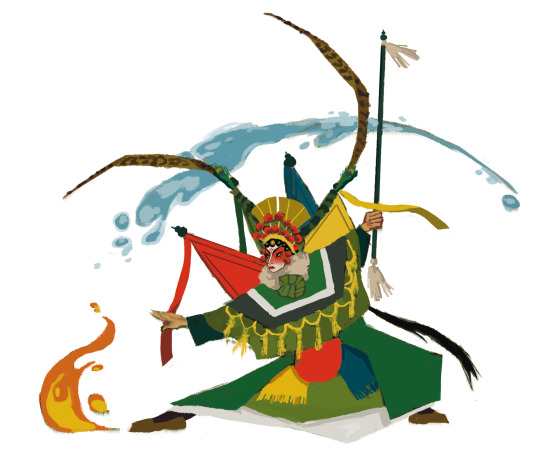
sticking w the peking opera design for avatar kyoshi’s redesign!! tried incorporating all 4 nations colours cuz shes the avatar lol,, instead of being based on a wudan she’s based on the daomadan, a strong female warrior
#avatar the last airbender#atla#avatar kyoshi#art#drawing#digitalart#digital art#fanart#avatar fanart#kyoshi#kyoshi warriors
78 notes
·
View notes
Text

Daomadan Lin Fei
140=>100
2 notes
·
View notes
Photo

They make a #homely setting out of a #dayspa #amazing #DaoMaDan #DMD #LifeInSuzhou #SuzhouLifestyle #weeklysparegime #andtherestidontcare . . . #CNIG #IGCN #wow #HappeningCN #Instadaily #instagood #like4like #photooftheday #igers #picoftheday #instamood #follow4follow #love #me #followme #beautiful #happy #cute (at Suzhou North Railway Station)
#dmd#cnig#happy#instamood#andtherestidontcare#followme#photooftheday#daomadan#dayspa#instagood#follow4follow#instadaily#igers#love#lifeinsuzhou#like4like#wow#picoftheday#amazing#happeningcn#weeklysparegime#cute#suzhoulifestyle#me#beautiful#homely#igcn
0 notes
Photo

Chinese Opera - Identity Map
Traditional Chinese Opera is a drama performance and musical theater in which includes many elements: music, dance, acting, and martial arts. It combined music, art and literature into one performance on the stage.
To have a Chinese Opera, there must be a Host who hires a Chinese Opera troupe. The members of the troupe are the owner, stylist, actors and musicians. Each members can switch roles and each members can play more than one roles.
Roles:
Sheng — Male Role
Laosheng - polished manners of the middle-aged mandarin official or scholar
Hongsheng - had a red face, a sub-category of Laosheng
Xiaosheng - handsome young male with no beard
Wusheng - good at martial arts roles
Dan — Female Roles
Zhengdan (Qingyi) - the main woman roles
Guimendan - an unmarried and young girl
Daomadan - a female warrior role
Huadan - the vivacious and unmarried woman role
Laodan - an old and clever woman
Wudan - a female acrobatic role
Jing - Painted Face Male Role
Tongchui - good at singing and usually a loyal general
Jiazi - good at acting with less emphasis on singing
Wujing - a martial arts and acrobatics role
Chou - the Comedy Role
Wenchou - a civilian role such as a merchant or jailer
Wuchou - a military role, skilled in acrobatics
Make up and costume:
The colors of the costume defines the role of the character. For instance, since green defines as violence, the antagonist character would wear green. The pattern on the costumes also have meaning. The pattern are usually flowers and dragons.
The actors always wear heavy makeup. White makeup defines as smooth, pale skin. Pink defines as healthy (when blood circulates well). Black defines as hair on the body.
Stage:
The stage that are usually use is a makeshift stage. The front part is for the performance, two sides are for musician, and back part is for preparation.
Performance:
Chinese Opera in Thailand is mostly Teochew Opera, which was brought to Thailand when Teochew people immigrated to Thailand. Chinese Opera occurs during festival/events:
Chinese New Year
Moon Festival
Vegetarian Festival
god’s birthday
Places:
The performance can be mostly found in the shrine. If there are big events, the can be found in big mall.
1 note
·
View note
Photo
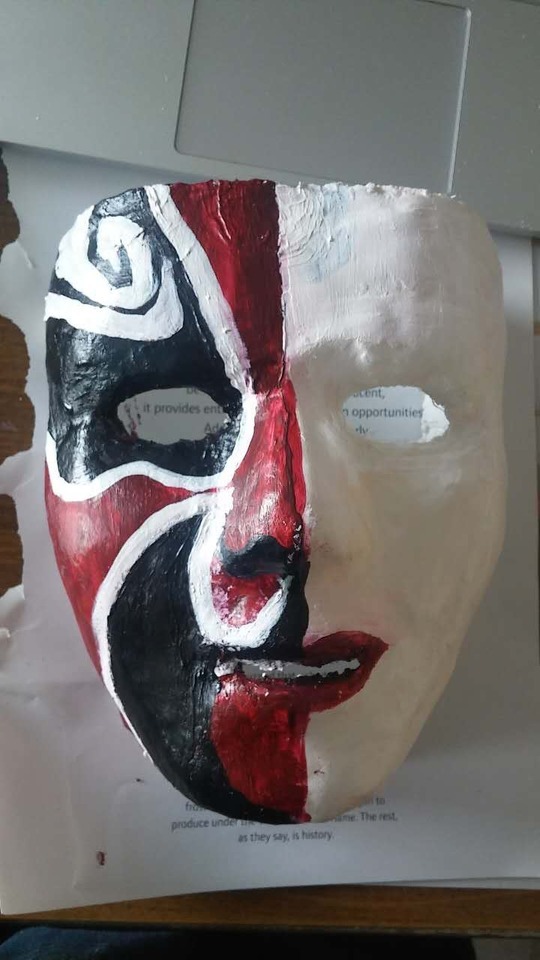

I started to paint on it, the best media to paint on it is acrylic. However, I do find the challenge of using the acrylic painting. The acrylic is too thick, so when I was using the brushes, the colour that paint on it is not smooth. Then I started to think about how to decorate the right part of the mask.
I want to explain the Chinese side of the mask a little bit.
Peking opera or Beijing opera (Chinese: 京剧; pinyin: Jīngjù) is a form of Chinese opera which combines music, vocal performance, mime, dance, and acrobatics. It arose in the late 18th century and became fully developed and recognized by the mid-19th century.[1] The form was extremely popular in the Qing dynasty court and has come to be regarded as one of the cultural treasures of China.[2] Major performance troupes are based in Beijing and Tianjin in the north, and Shanghai in the south.[3] The art form is also preserved in Taiwan (Republic of China), where it is known as Guójù (traditional Chinese: 國劇; simplified Chinese: 国剧; literally: "National theatre"). It has also spread to other countries such as the United States and Japan.[4]
The roles on the Peking Opera stage fall into four major roles-Sheng (生), Dan (旦), Jing (净), Chou (丑).[43]
Sheng (生): refer to men, divided into Laosheng (老生),Xiaosheng (小生),Wusheng (武生)
Dan (旦): refer to women, divided into Zhengdan (正旦), Laodan (老旦), Huadan (花旦), Wudan (武旦), Daomadan (刀马旦)
Jing (净): refer to painted-face role, know popularly as Hualian, divided into Zhengjing (正净), Fujing (副净), Wujing (武净), Maojing (毛净)
Chou (丑): refer to painted-face role, know popularly as Xiao hualian, divided into Wenchou (文丑), Wuchou (武丑), Nüchou (女丑)
The Sheng (生) is the main male role in Peking opera. This role has numerous subtypes. The laosheng is a dignified older role. These characters have a gentle and cultivated disposition and wear sensible costumes. One type of laosheng role is the hongsheng, a red-faced older male. The only two hongsheng roles are Guan Gong, the Chinese god of sworn brotherhood, loyalty and righteousness, and Zhao Kuang-yin, the first Song Dynasty emperor. Young male characters are known as xiaosheng. These characters sing in a high, shrill voice with occasional breaks to represent the voice changing period of adolescence. Depending on the character's rank in society, the costume of the xiaosheng may be either elaborate or simple.[50] On-stage, xiaosheng actors are often involved with beautiful women by virtue of the handsome and young image they project.[51] The wusheng is a martial character for roles involving combat. They are highly trained in acrobatics, and have a natural voice when singing.[50] Troupes will always have a laosheng actor. A xiaosheng actor may also be added to play roles fitting to his age. In addition to these main Sheng, the troupe will also have a secondary laosheng.[52]
The Dan (旦) refers to any female role in Peking opera. Dan roles were originally divided into five subtypes. Old women were played by laodan, martial women were wudan, young female warriors were daomadan, virtuous and elite women were qingyi, and vivacious and unmarried women were huadan. One of Mei Lanfang's most important contributions to Peking opera was in pioneering a sixth type of role, the huashan. This role type combines the status of the qingyi with the sensuality of the huadan.[53] A troupe will have a young Dan to play main roles, as well as an older Dan for secondary parts.[48] Four examples of famous Dans are Mei Lanfang, Cheng Yanqiu, Shang Xiaoyun, and Xun Huisheng.[54] In the early years of Peking opera, all Dan roles were played by men. Wei Changsheng, a male Dan performer in the Qing court, developed the cai qiao, or "false foot" technique, to simulate the bound feet of women and the characteristic gait that resulted from the practice. The ban on female performers also led to a controversial form of brothel, known as the xianggong tangzi, in which men paid to have sex with young boys dressed as females. Ironically, the performing skills taught to the youths employed in these brothels led many of them to become professional Dan later in life.[55]
The Jing (净) is a painted face male role. Depending on the repertoire of the particular troupe, he will play either primary or secondary roles.[48] This type of role will entail a forceful character, so a Jing must have a strong voice and be able to exaggerate gestures.[56] Peking opera boasts 15 basic facial patterns, but there are over 1000 specific variations. Each design is unique to a specific character. The patterns and coloring are thought to be derived from traditional Chinese color symbolism and divination on the lines of a person's face, which is said to reveal personality. Easily recognizable examples of coloring include red, which denotes uprightness and loyalty, white, which represents evil or crafty characters, and black, which is given to characters of soundness and integrity.[57] Three main types of Jing roles are often seen. These include tongchui, roles that heavily involve singing, jiazi, roles with less emphasis on singing and more on physical performance, and wujing, martial and acrobatic roles.[50]
The Chou (丑) is a male clown role. The Chou usually plays secondary roles in a troupe.[48] Indeed, most studies of Peking opera classify the Chou as a minor role. Chou roles can be divided into Wen Chou, civilian roles such as merchants and jailers, and Wu Chou, minor military roles. The Wu Chou is one of the most demanding in Peking opera, because of its combination of comic acting, acrobatics, and a strong voice. Chou characters are generally amusing and likable, if a bit foolish. Their costumes range from simple for characters of lower status to elaborate, perhaps overly so, for high status characters. Chou characters wear special face paint, called xiaohualian, that differs from that of Jing characters. The defining characteristic of this type of face paint is a small patch of white chalk around the nose. This can represent either a mean and secretive nature or a quick wit. Originally, there were five roles in Beijing Opera, but the last role "Mo" became a part of "Chou".[50]
https://en.wikipedia.org/wiki/Peking_opera#Performers_and_roles
0 notes
Video
dao ma dan刀马旦 from beijing opera by 甄妮刀马旦
12K notes
·
View notes
Photo

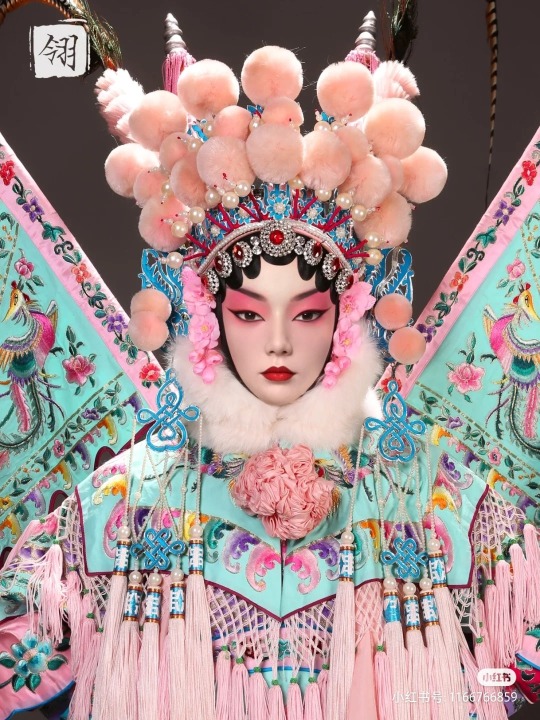
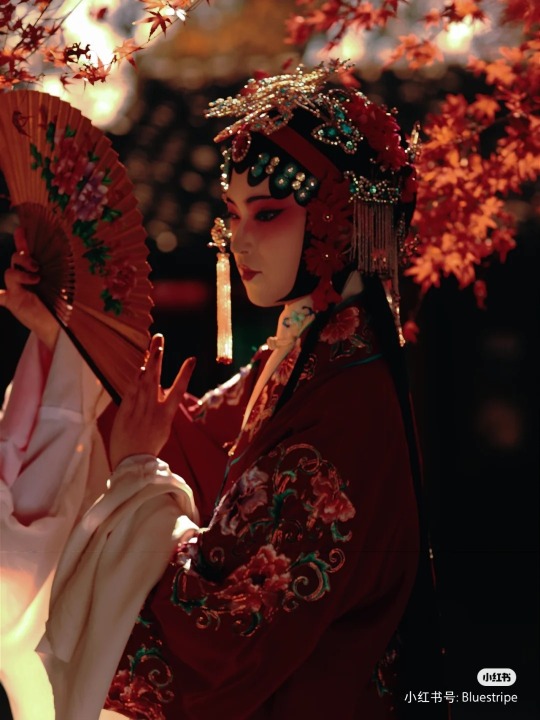

chinese opera
552 notes
·
View notes
Text
Ok I saw Yunjin. Tbh not a huge fan of her design lol, but I don’t dislike it either, it’s just kinda meh compared to designs of other characters we have seen so far. Whoever designed her could have modified the stereotypical Lolita dress a bit more in terms of shape and form to give her just a little more of that Beijing Opera daomadan feel, but oh well.
2 notes
·
View notes
